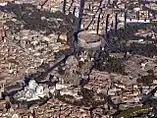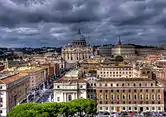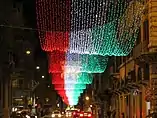Caput Mundi
Caput Mundi is a Latin phrase used to describe a city as the Capital of the World. Some major cities since the ancient times have been described as the Caput Mundi, the first being Rome and Jerusalem, and then Constantinople (today's Istanbul). Other important cities to have been called as the "Novum Caput Mundi" (New Capital of the world) after the medieval period include London and New York.

Cities
Rome
Roma Caput Mundi is a Latin phrase taken to mean "Rome capital of the world" and "Roma capitale del mondo" in Italian (literally: "head of the world";[2] see capital, capitol). It originates out of a classical European understanding of the known world: Europe, North Africa, and Southwest Asia.The influence of Rome in the ancient world began to grow around the 2nd century BC as the Republic expanded across Southern Europe and North Africa. For the next five centuries, Rome would govern much of the known world (of traditional Greco-Roman geography). The cultural influence of the local language of Rome (Latin) as well as Roman art, architecture, law, religion, and philosophy was significant. The Imperial city of Rome adopted as its nickname Caput Mundi, attributing this to its perception of an enduring power of Ancient Rome and the Roman Catholic Church. Today it still remains one of the most visited cities in the world.
Jerusalem
.jpg.webp)
Because of its religious, historical and political significance, Jerusalem has been both called Caput Mundi and Umbilicus Mundi. It has been an important territory in the life of Jesus and other Abrahamic prophets. The city still remains an important spiritual and a politically controversial site to the followers of Judaism, Christianity, Islam and Baháʼí Faith.[4][5][6][7][8]
Today, the status of Jerusalem remains one of the core issues in the Israeli–Palestinian conflict. According to David Ben-Gurion, "No city in the world, not even Athens or Rome, ever played as great a role in the life of a nation for so long a time, as Jerusalem has done in the life of the Jewish people."
Constantinople (Istanbul)
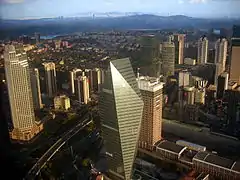
Constantinople, also known as Eastern Rome of the New Rome, was built as the second Caput Mundi by Emperor Constantine in 330 AD, the first Roman Emperor to openly convert to Christianity.[9] By 500 AD, Constantinople had somewhere between 400,000 and 500,000 people, edging out its predecessor, Rome, for world's largest city. It served as an imperial capital for almost 16 centuries. During much of the Middle Ages, Constantinople was the largest city in Europe.[10]
The Byzantine Empire lasted for over a thousand years with the center always at Constantinople, except between 1204 and 1261, when it was centered in the capitals of Nicaea, Trebizond, and Arta.
The city was seen as the "Capital of the World" because of its prime trading position in the center of the medieval world. This privileged position continued after its Islamic conquest, even as the capital of the Ottoman Empire. The Patriarch of Constantinople has been designated Ecumenical Patriarch since the sixth century, and has come to be regarded as the leader of the today 300 million Orthodox Christians.
Today, the city's name is Istanbul, based in Turkey. It is a megacity of 15 million people and the economic and cultural centre of Turkey, but not the capital, which is Ankara. Istanbul is Europe's largest city and one of the largest cities in the world.
London
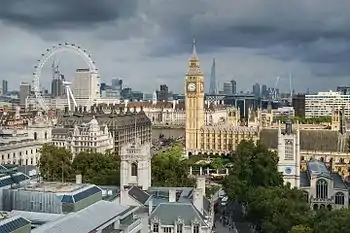
The capital of the British Empire, the largest empire in history, London, was often called the Novum Caput Mundi. It was part of the Roman Empire and has been major settlement since the epoch of Ancient Rome.
London still remains one of the world's leading business, financial, and cultural centres, and its influence in politics, education, technology, entertainment, media, fashion and the arts all contribute to its status as a major global city. Many of the world's largest corporations have their headquarters in London, the city taking a central role as a part of the wider global economy. In addition London in time and on maps is on the Prime Meridian, running directly through Greenwich (also known as the Greenwich Meridian), with its time zone as GMT+0 (UTC+0). The decision made at the International Meridian Conference was due to the dominance of the British Empire and the influence of British India; for logistical reasons, and because the United Kingdom and London remain a major global influence, this position of the Prime Meridian remains.[11]
London is the most-visited city as measured by international arrivals[12] and has the busiest city airport system as measured by passenger traffic.[13] It is the leading investment destination,[14][15][16][17] hosting more international retailers[18][19] and ultra high-net-worth individuals[20][21] than any other city. London's universities form the largest concentration of higher education institutes in Europe,[22] and is home of world-class institutions such as Imperial College London in science, technology, engineering, and mathematics and the London School of Economics in economics, finance, and business.[23][24][25]
In 2012, London became the first city to have hosted three modern Summer Olympic Games.[26] The situation of numerous iconic landmarks, such as Big Ben, St Paul's Cathedral, Tower Bridge, the Houses of Parliament, and Buckingham Palace, as well as modern architecture such as the Gherkin, The Shard, the London Eye and the O2 drew approximately 16.7 million international tourists in 2013, establishing London as the most visited city in the world for international tourists.[27] The city is also home of the world's largest library and botanical garden.
London was described as the capital of the "empire on which the sun never sets". It is presently the largest city by foreign born populations and has been ranked as the world's capital city in terms of culture, business, technological readiness and overall economic clout,[28] as well as attracting the most foreign investment of any global city.[29]
New York
.jpg.webp)
New York, the most populous city in the United States, is sometimes described by the Latin phrase "Novum Caput Mundi" ("New Capital of the World"); or more commonly by the English phrase, Capital of the World, primarily in reference to Manhattan, the core borough often referred to as simply The City by locals .[30][31] A leading global city, New York exerts a significant impact upon commerce, finance, media, art, fashion, research, technology, education, and entertainment, and the city's fast pace[32][33][34] has inspired the term New York minute.[35] Home to the headquarters of the United Nations,[36] New York is an important center for international diplomacy[37] and has been described as the cultural and financial capital of the world,[38][39][40][41][42][43] despite not being the modern capital of the United States. As many as 800 languages are spoken in New York, making it the most linguistically diverse city in the world.[44] In 2019, New York was voted the greatest city in the world per a survey of over 30,000 people from 48 cities worldwide, citing the city's cultural diversity.[45]
Numerous national and international private corporations have headquarters in New York. Anchored by Wall Street, in Lower Manhattan, New York has been called the world's principal financial center,[46] as well as most economically powerful city[47][42][48][49][50][51] and is home to the New York Stock Exchange, the world's largest stock exchange per total market capitalization of its listed companies.[52] The New York metropolitan region is defined by both the Metropolitan Statistical Area (19.9 million residents in 2013)[53] and the Combined Statistical Area (23.5 million residents in 2013).[54] In 2013, the MSA produced a gross metropolitan product (GMP) of nearly US$1.39 trillion,[55] while in 2012, the CSA[56] generated a GMP of over US$1.55 trillion, both ranking first nationally by a wide margin and behind the GDP of only twelve nations and eleven nations, respectively.[57]
New York has been ranked first among cities across the globe in attracting capital, business, and tourists.[58][59] Tourism is vital to New York, and many districts and landmarks in New York City have become well known, as the city received a record high 56 million tourists in 2014,[60] generating an all-time high US$61.3 billion in overall economic impact for New York City in 2014.[60] Several sources have ranked New York the most photographed city in the world.[61][62][63] Times Square, at the hub of the Broadway theater district, is nicknamed The Crossroads of the World,[64] The Center of the Universe,[65] and the "heart of the world".[66]
Washington, D.C.
The capital of the United States of America and the seat of the U.S. federal government, Washington, D.C. also holds the headquarters of important international organizations such as the World Bank, the International Monetary Fund, and the Organization of American States. The signing of the North Atlantic Treaty took place in Washington;[67][68] this treaty established NATO, which took part in the Cold War, and by its end, Washington was dubbed by The Washington Post as the capital of the world.[69]
Other Usages
Adolf Hitler, the dictator of the Third Reich, as part of his proposed New Order, planned to make Berlin the "Caput Mundi", directing Albert Speer to formulate the Welthauptstadt Germania—a plan to rebuild Berlin in an Imperial architectural style. The central edifice of Berlin would have been the Volkshalle, from which Hitler would have issued his Imperial decrees as the absolute ruler of Europe.
In recent times, Milan and Paris were considered Cosmicos Mundi, or fashion capitals of the world.[70]
See also
References
- Rome Seminar Archived 4 December 2008 at the Wayback Machine
- "Dictionary of Latin Phrases and Proverbs: C". Latin-phrases.co.uk. Retrieved 3 January 2012.
- Adolf Erik Nordenskiöld (1889). Facsimile-atlas to the Early History of Cartography: With Reproductions of the Most Important Maps Printed in the XV and XVI Centuries. Kraus. pp. 51, 64.
- Wolf, Beat (2010). Jerusalem und Rom, Mitte, Nabel - Zentrum, Haupt: Die Metaphern "Umbilicus mundi" und "Caput mundi" in den Weltbildern der Antike und des Abendlands bis in die Zeit der Ebstorfer Weltkarte. ISBN 9783039111619.
- Viterbo), Cardinal Egidio (da (1992). "Giles of Viterbo OSA: Letters as Augustinian general, 1506-1517".
- Wisch, Barbara (1986). "Italian Renaissance Art: Selections from the Piero Corsini Gallery".
- Den Hartog, E. (1992). Romanesque Architecture and Sculpture in the Meuse Valley. ISBN 9789074252041.
- Erdeljan, Jelena (21 June 2017). Chosen Places: Constructing New Jerusalems in Slavia Orthodoxa. ISBN 9789004345799.
- Mango, Cyril (1991). "Constantinople". In Kazhdan, Alexander (ed.). The Oxford Dictionary of Byzantium. Oxford and New York: Oxford University Press. pp. 508–512. ISBN 0-19-504652-8.
- Pounds, Norman John Greville. An Historical Geography of Europe, 1500–1840, p. 124. CUP Archive, 1979. ISBN 0-521-22379-2.
- "The Global Financial Centres Index 24" (PDF). China Development Institute, Z/Yen Group. September 2018. Retrieved 11 May 2019.
- "London tops ranking of destination cities". The Independent. London. 1 June 2011. Archived from the original on 3 June 2011. Retrieved 12 June 2012.
- "Beijing to overtake London as world's largest aviation hub". Centre for Aviation. Retrieved 12 June 2012.
- "Global Cities Investment Monitor 2017" (PDF). KPMG. Archived from the original (PDF) on 5 September 2017. Retrieved 5 September 2017.
- "Global Cities Investment Monitor 2016" (PDF). KPMG. Retrieved 12 September 2016.
- "Global Investor Intentions Survey 2015". CBRE. Retrieved 27 August 2015.
- "London Top Target for Global Investors, Secondary Markets Gain Popularity". World Property Journal. Retrieved 27 August 2015.
- "Global Retail Report 2014". CBRE. Retrieved 27 August 2015.
- Bourke, Joanna (18 May 2015). "London retains title as world's most international shopping destination". London Evening Standard. Retrieved 27 August 2015.
- "The Wealth Report 2015". Knight Frank. Retrieved 27 August 2015.
- Bourke, Joanna (11 March 2015). "NYC Is No Longer the No. 1 City for the Super-Wealthy". Curbed. Retrieved 27 August 2015.
- "Number of international students in London continues to grow" (Press release). Greater London Authority. 20 August 2008. Archived from the original on 24 November 2010.
- "Times Higher Education World University Rankings".
- "Top Universities: Imperial College London".
- "Top Universities: LSE". Retrieved 21 September 2019.
- "IOC elects London as the Host City of the Games of the XXX Olympiad in 2012". International Olympic Committee. 6 July 2005. Retrieved 3 June 2006.
- "Archived copy". Archived from the original on 25 September 2015. Retrieved 19 September 2017.CS1 maint: archived copy as title (link)
- http://www.pwc.com/us/en/press-releases/2014/london-tops-pwcs-cities-of-opportunity-study.jhtml
- http://www.londonlovesbusiness.com/business-news/london-attracts-most-foreign-investment-of-any-other-city/1923.article
- "About New York City". The City of New York. Archived from the original on 7 April 2014. Retrieved 1 May 2016.
- Eugene J. Sherman. "FORWARD New York – Capital of the Modern World". The Weissman Center for International Business. Retrieved 1 May 2016.
- Kelsy Chauvin (15 March 2019). "15 Things NOT to Do in New York City". Fodor's. Retrieved 23 March 2019.
There are more than 8.6 million citizens of New York City, and they’re pretty much all in a hurry. They’re also shrewd, outspoken, and proudly able to survive in a metropolis that tends to punish the meek. The buzzing subway system alone is a symbol of how this city works: part ballet, part battlefield. Residents and visitors alike can see why New York is considered the greatest city in the world.
- Poliak, Shira. "Adjusting To New York City". Sun Sentinel. Archived from the original on 3 December 2015. Retrieved 1 November 2015.
Additionally, the fast-paced lifestyle of New York City demands adjusting.
- Stephen Miller (2016). Walking New York: Reflections of American Writers from Walt Whitman to Teju Cole. pp. 46, 50, 131. ISBN 978-0-8232-7425-3. Retrieved 10 May 2017.
- "Dictionary – Full Definition of NEW YORK MINUTE". Merriam-Webster. Retrieved 1 November 2015.
- "United Nations Visitors Centre". United Nations. 2011. Archived from the original on 24 September 2010. Retrieved 1 May 2016.
- "NYC Mayor's Office for International Affairs". The City of New York. Archived from the original on 16 June 2015. Retrieved 1 May 2016.
- "Consulate General of Iceland New York Culture". Consulate General of Iceland New York. Archived from the original on 5 February 2013. Retrieved 1 May 2016.
- "Consulate of Latvia in New York". Consulate of Latvia. Archived from the original on 8 February 2013. Retrieved 1 May 2016.
- "Introduction to Chapter 14: New York City (NYC) Culture". The Weissman Center for International Business Baruch College/CUNY 2011. Archived from the original on 5 May 2013. Retrieved 1 May 2016.
- "New York, Culture Capital of the World, 1940–1965 / edited by Leonard Wallock ; essays by Dore Ashton ... [et al.]". NATIONAL LIBRARY OF AUSTRALIA. Retrieved 1 May 2016.
- "Top 8 Cities by GDP: China vs. The U.S." Business Insider, Inc. 31 July 2011. Retrieved 1 May 2016.
For instance, Shanghai, the largest Chinese city with the highest economic production, and a fast-growing global financial hub, is far from matching or surpassing New York, the largest city in the U.S. and the economic and financial super center of the world.
- "PAL sets introductory fares to New York". Philippine Airlines. Retrieved 1 May 2016.
- Roberts, Sam (1 May 2016). "Listening to (and Saving) the World's Languages". The New York Times. Retrieved 29 April 2010.
- Will Gleason (11 March 2019). "Citing its diversity and culture, NYC was voted best city in the world in new global survey". TimeOut. Retrieved 19 May 2019.
After compiling the thoughts of over 30,000 people, both from our NYC readership and half-a-world away, New York was voted the greatest city on the planet for 2019. In a hint as to why this happened, and why now, it also lead the categories of most diverse metropolis and best culture.
- Huw Jones (4 September 2018). "United States top, Britain second in financial activity: think-tank". Thomson Reuters. Retrieved 4 September 2018.
Think-tank New Financial’s study, which focuses on the "raw" value of actual domestic and international financial activity like managing assets and issuing equity, underscored the overall dominance of New York as the world’s top financial center.
- Richard Florida (3 March 2015). "Sorry, London: New York Is the World's Most Economically Powerful City". The Atlantic Monthly Group. Retrieved 25 March 2015.
Our new ranking puts the Big Apple firmly on top.
- "PAL sets introductory fares to New York". Philippine Airlines. Retrieved 25 March 2015.
- Richard Florida (8 May 2012). "What Is the World's Most Economically Powerful City?". The Atlantic Monthly Group. Retrieved 25 March 2015.
- John Glover (23 November 2014). "New York Boosts Lead on London as Leading Finance Center". Bloomberg L.P. Retrieved 23 March 2015.
- Accessed 23 March 2019.
- "2013 WFE Market Highlights" (PDF). World Federation of Exchanges. p. 5. Archived from the original (PDF) on 27 March 2014. Retrieved 24 March 2015.
- "The 10 Largest Metro Areas on July 1, 2013" (PDF). U.S. Census Bureau. Retrieved 27 March 2014.
- "Annual Estimates of the Resident Population: April 1, 2010 to July 1, 2013 - Combined Statistical Area; and for Puerto Rico". U.S. Census Bureau. Archived from the original on 27 June 2014. Retrieved 28 June 2014.
- "Gross Metropolitan Product (GMP) of the United States in 2013, by metropolitan area (in billion current U.S. dollars)". Statista. Retrieved 12 September 2014.
- "Revised Delineations of Metropolitan Statistical Areas, Micropolitan Statistical Areas, and Combined Statistical Areas, and Guidance on Uses of the Delineations of These Areas" (PDF). Executive Office of the President – Office of Management and Budget. p. 106. Retrieved 27 June 2014.
- "U.S. Metro Economies (note CSA 2012 GMP total includes sum of New York, Bridgeport, New Haven, Allentown, Trenton, Poughkeepsie, and Kingston MSA 2012 GMP values cited)" (PDF). IHS Global Insight, The United States Conference of Mayors, and The Council on Metro Economies and the New American City. November 2013. pp. 9 through 18 in Appendix Tables. Archived from the original (PDF) on 5 March 2015. Retrieved 27 June 2014.
- Simon Kennedy (13 April 2014). "Beijing Breaks into Top Ten in Rankings by A.T. Kearney". Bloomberg L.P. Retrieved 2 May 2014.
- Michelle Kaske (12 March 2012). "New York City Tops Global Competitiveness, Economist Report Says". Bloomberg L.P. Retrieved 2 May 2014.
- Ellen Wulfhorst, editing by Eric Beech (2 February 2015). "New York City tourism hit record high in 2014, officials say". Thomson Reuters. Retrieved 13 April 2015.
- DL Cade (27 December 2013). "Google Maps Out the Most Photographed Places in the World". PetaPixel. Archived from the original on 24 January 2014. Retrieved 23 January 2014.
- DL Cade (13 December 2013). "Most Instagrammed Locations and Cities of 2013 Revealed, as Well as Most-Liked Photo". PetaPixel. Archived from the original on 1 February 2014. Retrieved 23 January 2014.
- Sean O'Neill (12 June 2011). "The 25 most photographed places on Earth". NBCNews.com. Retrieved 23 January 2014.
- Allan Tannenbaum. "New York in the 70s: A Remembrance". The Digital Journalist. Retrieved 1 May 2016.
- Explore Manhattan Neighborhoods: The Center of the Universe (aka Times Square). Her Campus (22 March 2011). Retrieved on 1 May 2016.
- Noah Remnick and Tatiana Schlossberg (24 August 2015). "New York Today:Transforming Times Square". The New York Times. Retrieved 1 May 2016.
- "North Atlantic Treaty". Truman Library. Retrieved 3 January 2012.
- "NATO – Official text: The North Atlantic Treaty, 04-Apr. 1949". Nato.int. 9 December 2008. Retrieved 3 January 2012.
- Broder, David S. "Nation's Capital in Eclipse as Pride and Power Slip Away", The Washington Post, 18 February 1990. Retrieved 18 October 2010. "In the days of the Truman Doctrine, the Marshall Plan and the creation of NATO, [Clark Clifford] said, we saved the world, and Washington became the capital of the world."
- Shaw, Catherine (17 July 2016). "Milan, the 'world's design capital', takes steps to attract visitors year-round". South China Morning Post. Retrieved 15 October 2017.
